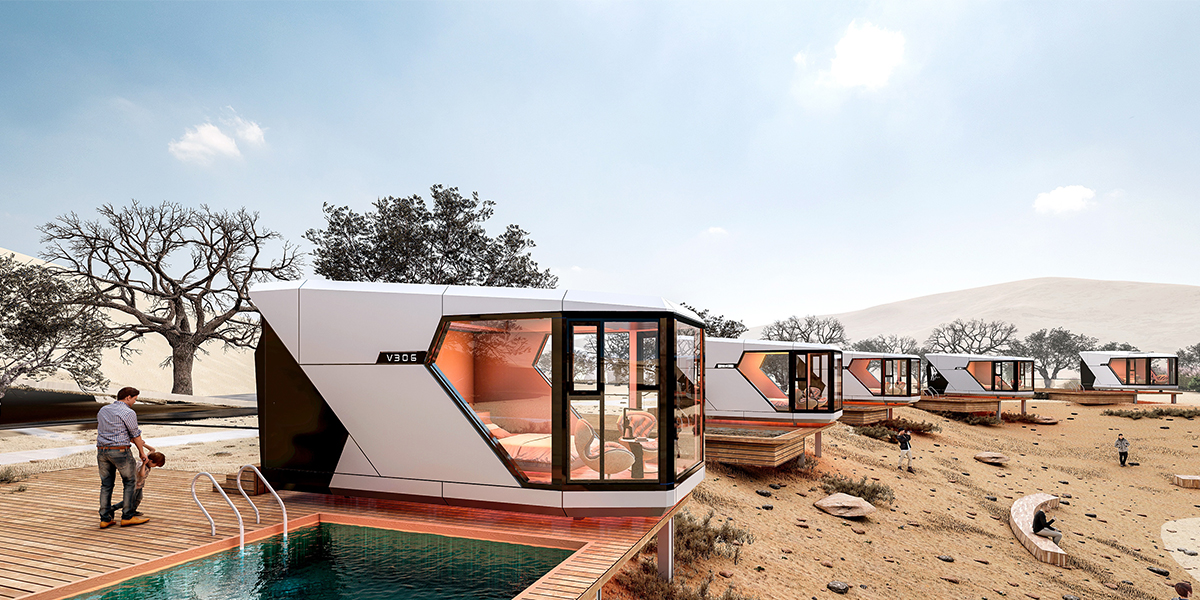
21 Jul Comparing Prefab Capsule Houses and Tiny Homes for Modern Living
Table of Contents
You might ask which housing choice is best for you. If you want a green place for short trips, a prefab capsule house is a good pick. It is quick to build, costs less, and saves energy. If you want to stay longer, tiny homes give you more room and special features. They are also good for the planet. Both options are getting more popular around the world. People like them because they are cheap, good for the earth, and look nice.
People often pick these homes for:
quick and cheap building
good size for one person, couples, or older people
Key Takeaways
Prefab capsule houses are fast to build. They are simple to move. They cost less at first. This makes them good for short stays or if you move a lot. Tiny homes give you more room. They have more privacy and comfort. They are better for living in for a long time. They are good for families too. Both types use eco-friendly materials. They have energy-saving features. These help you save money. They also help the environment. Think about your lifestyle and budget. Think about how long you will stay. This helps you pick between a capsule house and a tiny home. Look at local building rules. Get your site ready before you move in. This helps you set up easily and follow the law.
Key Differences
Prefab Capsule House Overview
A prefab capsule house does not look like a regular tiny home. It has a small, pod shape that seems very modern. These mini modular homes are made in a factory and arrive ready to set up. Capsule houses use strong but light materials, such as aerospace aluminum, galvanized steel, and composite panels. These help the house stand up to storms and earthquakes. The special insulation can lower energy use by as much as 65%. This helps you spend less on heating and cooling. You can move a capsule house without needing a trailer. It is easy to put together or take apart, so it is great for people who move a lot or need a place for a short time.
Tip: A prefab capsule house is easier to move and set up than a regular tiny home.
Tiny Home Overview
Tiny homes, or traditional tiny houses, look like small versions of normal houses. These mini modular homes are often built with wood or plywood. This makes them feel warm and classic, but you may need to do more work to keep out rain and wind. Tiny homes usually have more space than capsule houses. You get a kitchen, a bathroom, and sometimes a living room. These mini modular homes are good for living in for a long time because they are more comfortable and have more storage. But you need a trailer to move a tiny home, and setting it up takes longer. If you want to stay in one place, a tiny home might be better for you.
Here is a table that shows the main differences between a prefab capsule house and a traditional tiny home:
Aspect | Prefab Capsule Houses | Tiny Homes |
|---|---|---|
Design | Small, modern pod shape; made in a factory for easy moving and building. | Looks like a regular house; more like a permanent home. |
Materials | Light, strong materials like aerospace aluminum, galvanized steel, and composites. | Usually wood or plywood; needs more care for weather. |
Size & Space | Smaller, uses space well; has only what you need. | Bigger inside; has a kitchen, bathroom, and living areas. |
Mobility | Very easy to move; no trailer needed; fast to build or take apart. | Harder to move; needs a trailer; takes longer to set up. |
Which Is Better for Long-Term or Short-Term Living?
Think about how long you want to live in your home. If you need a place for a short time, capsule houses or mini modular homes are best. They are quick to set up and easy to move. If you want to stay for many years, traditional tiny homes give you more space and comfort. These mini modular homes feel more like a real house and are better for long-term living.
Note: Capsule houses are best for short stays and moving a lot. Traditional tiny homes are better for comfort and living in one place for a long time.
The main differences between a prefab capsule house and a traditional tiny home are design, materials, space, and how easy they are to move. Mini modular homes like capsule houses are fast and flexible. Traditional tiny homes look classic and have more room. Pick the one that fits your life and how long you want to stay.
Design & Structure
 Prefab Capsule House Design
Prefab Capsule House Design
A prefab capsule house looks like a modern pod. It is different from regular tiny homes. These mini modular homes use many materials to stay strong and light. The main frame is often steel. Steel helps the house last a long time. Aluminum covers the outside panels. This keeps the house light and stops rust. Inside, you might see fiberglass parts. Fiberglass is easy to clean and shape. Composite panels are made from wood, plastic, and resin. They make the house stronger and warmer. Polyurethane foam fills the walls. This keeps the temperature steady but does not add much weight.
Prefab capsule houses are built in factories. Each unit is made with care. Workers bring the finished mini modular homes to your site. This means setup is fast and there is less waste. These homes can fit in many places. You can move capsule houses easily. They are good for people who need to move a lot. The design is made for quick setup and saving energy. That is why these mini modular homes are great for short trips or city life.
Tip: Prefab capsule houses are strong, save energy, and you can move them almost anywhere.
Tiny Home Design
Tiny homes look like small regular houses. Builders use wood or plywood for a warm look. These mini modular homes use space in smart ways. You often see beds that fold into sofas. Some tables can be tucked away. Storage is hidden in stairs, under benches, or on walls. Open floor plans take away extra walls. This makes the space feel bigger.
There are clear spots for sleeping, cooking, and relaxing. Big windows and light colors let in lots of sun. This makes the inside feel open. Many tiny houses have small decks or patios. These outdoor spaces give you more room. Traditional tiny houses are best for people who want to stay in one place. They are cozy and last a long time.
Multi-purpose furniture helps save space.
Built-in shelves and tall storage keep things neat.
Open layouts and big windows make rooms feel larger.
Mini modular homes like tiny houses help you live simply and comfortably. You get a home that is both personal and useful.
Space & Comfort
Living Space
When you look at living space, you want to know how much room you get in each type of home. Prefab capsule houses come in different models. The E15 model gives you about 200 square feet. The largest, E40 and E40S, offer up to 408 square feet. Here is a table that shows the size of each model:
Model | Approximate Square Footage (sq ft) |
|---|---|
E15 | 200 |
E25 | 265 |
E30 | 320 |
E40 | 408 |
E40S | 408 |
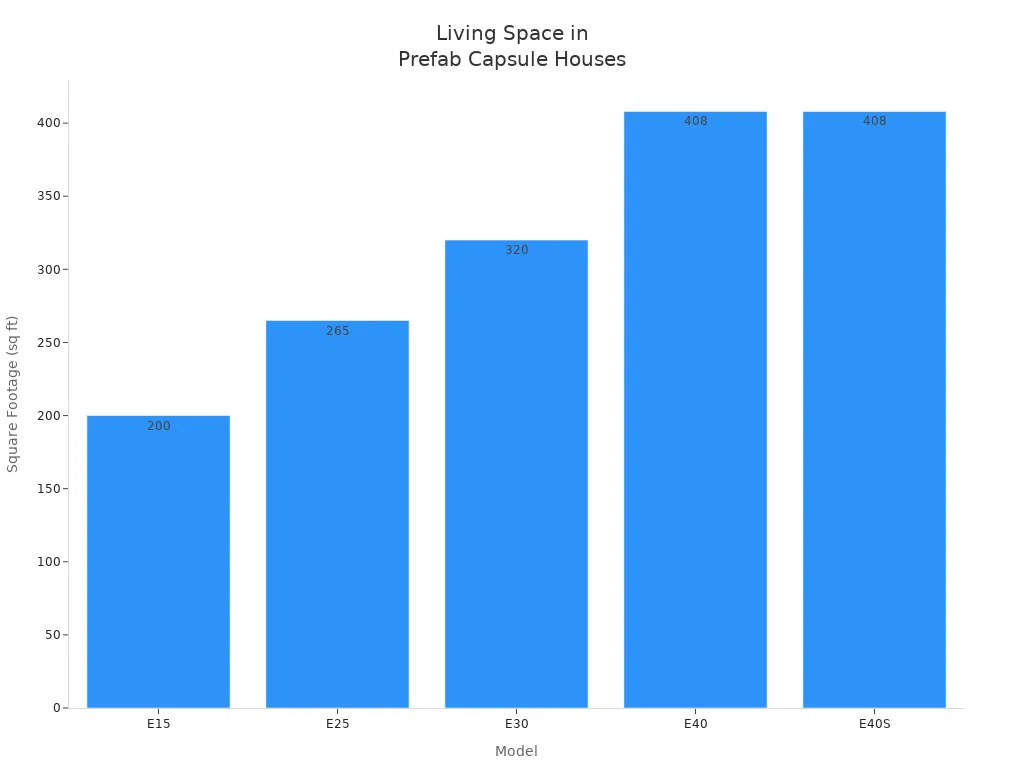
Capsule houses are usually wider than tiny homes built from shipping containers. You get about 10.5 feet in width, which feels more open than the 8 feet you find in most container-based tiny houses. The standing height in capsule houses is about 7 feet 10.5 inches. Tiny houses often give you a bit more height, usually between 8.5 and 9.5 feet. The extra width in capsule houses helps you move around more easily, even if the ceiling is a little lower.
Tiny homes and tiny houses often have more total space than capsule houses. Many tiny houses offer a kitchen, a bathroom, and a living area. You can use the space for different activities, like cooking, relaxing, or working. This makes tiny homes a good choice if you want to live in one place for a long time.
Privacy & Storage
Privacy matters when you live in a small space. Tiny houses use smart layouts to give you private areas. You might find a sleeping loft or a bedroom with a door. Some tiny homes have sliding doors or curtains to separate spaces. This helps you feel comfortable, even in a small home.
Storage is another big factor. Tiny houses use built-in shelves, under-bed drawers, and tall cabinets. You can keep your things neat and out of sight. Capsule houses have less storage, but you still get some hidden spaces under benches or inside walls. You may need to bring fewer things if you choose a capsule house.
Tip: If you want more privacy and storage, tiny houses and tiny homes give you more options. Capsule houses work best if you travel light and do not need much storage.
Mobility & Flexibility
Moving Prefab Capsule Houses
Prefab capsule houses are easy to move. They come ready from the factory. You do not need a trailer to move them. A trucking company brings your house on a semi-trailer. When it gets there, a crane puts it in place. You must get the ground ready before it comes. Use gravel or a concrete pad for the base. You also need water, sewer, and power set up first.
Here is a table that shows the main legal and moving steps for prefab capsule houses:
Aspect | Prefab Capsule Houses Requirements | Notes on Tiny Homes Comparison |
|---|---|---|
Legal Requirements | Follow local building codes and zoning rules; permits depend on where you live; ask local officials and builders | Tiny homes may need different permits |
Import & Customs | Import fees and shipping costs are included; shipping takes 15-35 days | Tiny homes are often built nearby, so less import work |
Transportation Logistics | Moved by semi-trailer; crane needed to unload | Tiny homes can be smaller and sometimes do not need a crane |
Site Preparation | Ground must be flat and strong; utilities must be ready | Tiny homes may need skids or a small base |
Installation | Set up utilities on site; hire workers to help | Tiny homes can be easier to install |
Damage Handling | Covered with fabric during shipping; check for damage when it arrives | Tiny homes need the same care |
Tip: Always check the rules in your area before moving your capsule house. Some places have strict building laws.
Moving Tiny Homes
Tiny homes let you pick where you want to live. Many tiny homes have wheels, so you can pull them with a truck. This makes moving easy, but you should not move them a lot. Bumpy roads and too much moving can hurt the house. Experts say to keep your tiny home in one spot for at least six months. This helps your house last longer and keeps repairs low.
You still need to follow the rules when you move a tiny home. Some places need special permits or have parking rules. You may need to get the ground ready with skids or a small base. Water and power must be ready before you move in. Tiny homes are lighter than capsule houses, so you may not need a crane. You can often move them with a big pickup truck.
Note: Tiny homes can move, but moving too much can cause damage. Plan each move to keep your house safe.
Efficiency & Energy Efficiency
 Prefab Capsule House Efficiency
Prefab Capsule House Efficiency
Prefab capsule houses are very good at saving energy. They use special insulation like polyurethane foam and extruded board. This keeps heat inside in winter and outside in summer. The house is built so air cannot leak in or out. This helps you pay less for heating and cooling. Some capsule houses have smart systems. These control the heat, air, and lights. The systems know when you are home and what the weather is like.
Capsule houses can have extra features for cold weather. You can add floor heating or water pipe insulation. Some have triple-layer Low-E glass windows. These things make the house warmer and save more energy. Capsule houses often use materials that are good for the earth. This helps you use less energy and helps nature. Some models let you add solar panels or wind turbines. These give you clean energy and help you save money.
Tip: Good insulation and smart systems help prefab capsule houses save energy and keep you comfortable.
Main features in prefab capsule houses:
Special insulation that keeps heat in or out
Airtight build for better energy savings
Smart systems to save energy
Choices for solar and other clean energy
Tiny Home Energy Efficiency
Tiny homes also try to save energy. Builders use good insulation to keep you warm or cool. You can pick strong windows and doors to stop heat from leaving. Many tiny homes use appliances that do not use much power. Solar panels are used a lot. You can put them on the roof or use ones you can move. Batteries let you store power for later.
You can add wind or micro-hydro systems to your tiny home. These help you live without using city power and save money. You should clean and check your solar panels often. This keeps them working well. Tiny homes use solar power with lights and appliances that save energy. This lets you control how much energy you use and save money.
Feature | Prefab Capsule House | Tiny Home |
|---|---|---|
Advanced Insulation | Yes | Yes |
Smart Home Systems | Yes | Sometimes |
Solar Integration | Optional | Common |
Energy-Efficient Design | Yes | Yes |
Renewable Energy Options | Solar, Wind | Solar, Wind, Micro-hydro |
Note: Both prefab capsule houses and tiny homes use good insulation and clean energy to save money and help the planet.
Sustainability and Environmental Impact
Capsule House Sustainability
Prefab capsule houses care about the environment from the start. They use recycled steel and reclaimed wood. This helps cut down on harm to nature when building. The modular design means less waste is made. This makes building better for the earth. Many capsule houses have solar panels and smart thermostats. These help you use less energy and lower your carbon footprint.
Capsule houses are small, so you need less light, heat, and cooling. This means you pay less for energy and make less pollution. You can move these homes easily. You do not need to build a new house each time you move. This saves resources and helps the planet even more. Capsule houses also need less fixing over time. This saves even more resources.
Here is a table that shows how capsule houses and tiny homes compare for being green:
Criteria | Capsule Houses | Traditional Tiny Homes / Homes |
|---|---|---|
Size and Resource Use | Compact size reduces lighting, heating, cooling | Larger size generally increases energy use |
Materials | Recycled steel, reclaimed wood, modular design | Natural materials like straw, clay, wood |
Energy Efficiency | Built-in energy-saving tech (solar panels, smart thermostats) | Natural insulation reduces energy demand by 32-59% |
Construction Waste | Modular design reduces waste | Traditional building methods may produce more waste |
Environmental Impact | Lower carbon footprint due to size and tech | Eco-friendly through natural materials and practices |
Cost and Maintenance | Lower upfront cost, less maintenance | Potentially higher cost, more customization |
Additional Features | Portability, smart home features | Rainwater collection, composting toilets |
Capsule houses use smart tech and modular design to help the earth. You get a home that is green and easy to care for.
Tiny Home Sustainability
Tiny homes are also good for the earth. Builders use eco-friendly things like local wood, bamboo floors, and sheep wool for insulation. These choices help the planet and make the air inside better. You can add solar panels to tiny homes. This lets you use clean energy and need less from the power grid.
Tiny homes often have rainwater tanks, greywater systems, and composting toilets. These help you save water and make less waste. Many tiny homes use LED lights and appliances that use less power. Smart tech can help you control how much energy you use.
Tiny homes use safe, green materials like reclaimed wood and recycled denim insulation.
You can save space with furniture that does more than one thing and tall shelves.
Water-saving features include low-flow showers, rainwater tanks, and composting toilets.
You can live off-grid with solar panels, batteries, and water systems.
Tiny homes are built to be green and use natural materials. You can make your home fit your needs and help the planet at the same time. Both capsule houses and tiny homes help you live in a way that is better for nature.
Cost & Affordability
Upfront Costs
Prefab capsule houses usually cost less at the start. Most cost between $39,000 and $99,000. The price depends on size and features. You get modern things and smart tech included. Eco-friendly materials are part of the deal. These homes are built in a factory. This saves money on workers. They also arrive ready to use. You do not wait long to move in. This makes prefab capsule houses a good choice for saving money.
Tiny homes can cost a lot or a little. Custom tiny homes often cost more. They take longer to build and need more work. Special features or cool designs raise the price. You must also pay for land, permits, and hooking up utilities. Both types of homes need these extra costs. Loans with low interest can help you pay for prefab capsule houses.
Note: Prefab capsule houses are faster to set up and need less work. This makes them cheaper at the start than tiny homes.
Ongoing Expenses
Ongoing costs are important if you want to stay long. Prefab capsule houses use strong metals like aircraft-grade aluminum and galvanized steel. These last a long time and do not break easily. Good insulation helps you save up to 65% on energy bills. You pay less for heat and air each month.
Tiny homes use wood, which can rot or get bugs. You may have to fix things more often. If the insulation is not good, your bills go up. Tiny homes sometimes have space you do not use. This can make costs higher.
Here is a table to show the ongoing costs:
Aspect | Prefab Capsule Houses | Tiny Homes |
|---|---|---|
Building Materials | Aircraft-grade aluminum, galvanized steel (durable) | Wood (can rot, needs more care) |
Insulation & Energy Efficiency | High-quality, saves up to 65% on energy | Lower quality, higher heating/cooling costs |
Maintenance Requirements | Minimal, lasts longer | Higher, needs more repairs |
Utility Expenses | Lower due to efficient design | Higher due to less insulation |
Prefab capsule houses are a smart way to save money over time. They cost less to keep up and use strong materials. You also save on energy. Tiny homes can cost more to fix and to heat or cool. When you think about money, prefab capsule houses often give you better value and are easier to care for.
Practicality & Everyday Use
Daily Living
You want your home to work for your daily life. Prefab capsule houses give you a simple space. You can cook, sleep, and relax in one room. The design lets you switch tasks fast. Built-in furniture and smart storage save space. Cleaning is quick because the area is small. Everything is easy to reach.
Tiny homes feel more comfortable for daily living. You get different rooms for sleeping, cooking, and relaxing. Many tiny homes have a real kitchen with a stove and fridge. You can take a hot shower in your own bathroom. Storage helps you keep things neat. You can add shelves, closets, or a small desk for work.
Living in a tiny home feels like a regular house. You get more privacy and can set up your space how you want.
Feature | Prefab Capsule House | Tiny Home |
|---|---|---|
Cooking Area | Basic kitchenette | Full kitchen |
Sleeping Space | Open or lofted bed | Separate bedroom |
Storage | Limited, built-in | More options |
Bathroom | Compact, shared | Private, larger |
Entertaining & Hosting
Space is important when you have friends over. Prefab capsule houses are small, about 200 square feet. It is hard to have more than one or two guests. The open room means everyone shares the same space. Thin walls do not block noise well. You may worry about privacy. The small space can feel crowded if you eat or play games together.
Tiny homes give you more ways to host guests. You can use a small table or go outside on a deck. Some tiny homes have sliding doors or curtains for privacy. You can invite friends for dinner or a movie. Extra space and better walls help everyone feel at ease.
Capsule houses make it hard for guests to move around.
Thin walls do not keep conversations private.
Open rooms mean less personal space at parties.
Tiny homes give you more room and choices for guests.
If you like having people over, a tiny home gives you more ways to make guests feel welcome.
Construction Speed
Prefab Capsule House Setup
You can set up a prefab capsule house very quickly. The house arrives at your site already built in a factory. Workers use machines to lift it into place. You do not need to wait for months. Most people move in within a few days after delivery. The setup process is simple and fast.
Here is what you can expect when you choose a prefab capsule house:
The house arrives ready to use.
Workers connect water, power, and sewer lines.
You check for any damage from shipping.
You move in after a quick inspection.
Tip: You can save time by preparing your site before the house arrives. Make sure the ground is flat and utilities are ready.
A typical prefab capsule house takes about 1 to 3 days to set up once it arrives. You do not need to worry about weather delays because most of the work happens indoors at the factory. This makes capsule houses a great choice if you want to move in fast.
Tiny Home Build Time
Tiny homes take longer to build than prefab capsule houses. Builders often start from scratch. You may wait several weeks or even months before your home is ready. The time depends on the design, materials, and builder’s schedule.
Here is a simple timeline for a tiny home:
Step | Time Needed |
|---|---|
Design & Planning | 1-2 weeks |
Building Structure | 4-8 weeks |
Interior Finishing | 2-4 weeks |
Utility Hookups | 1 week |
You may need to wait up to 3 months for a custom tiny home. Weather can slow down outdoor building. Custom features or special materials can add more time.
Note: If you want to move in quickly, prefab capsule houses are much faster than tiny homes. Tiny homes give you more choices, but you need to wait longer for your dream home.
Choosing the Best Option
 Lifestyle Fit
Lifestyle Fit
You want a home that fits your life and goals. Both prefab capsule houses and tiny homes have special benefits. They work for different people and ways of living. If you want to save money, both choices help lower your costs. Students and young workers can afford these homes. People with small budgets like them too. If you care about the earth, you will like their green materials. These homes use less energy than normal houses. They also make less pollution.
If you like simple living, small spaces help you keep only what you need. Minimalists feel happy in these homes. If you move a lot or work from many places, capsule houses are easy to move. Their light and modular design makes moving simple. You can set up your home in new spots without much work. If you want your home to feel special, both types let you pick your own style.
Here is a table to show how these homes fit different lives:
Lifestyle Feature | How Capsule Houses & Tiny Homes Fit You |
|---|---|
Affordability | Great for saving money and lowering bills |
Eco-Friendliness | Use green materials and save energy |
Minimalism | Small spaces help you focus on essentials |
Mobility & Flexibility | Easy to move or adjust for changing needs |
Customization | Options to personalize layout and features |
Decision Factors
When you pick between a prefab capsule house and a tiny home, think about what matters most to you. If you want a home that moves easily, capsule houses are best. They are light, modular, and fast to set up. If you need more room, a tiny home gives you a bigger kitchen and bathroom. You get more privacy and can have friends over more easily.
Think about your money. Capsule houses cost less at first and save you money on bills. Tiny homes may cost more but give you more comfort and space. If you want to help the earth, both choices use green materials and save energy.
Here is a quick list of things to think about:
Pick a capsule house if you want to move a lot, spend less, and live simply.
Choose a tiny home if you want more space, privacy, and a classic house feel.
Check the building rules in your area before you decide.
Think about how much you want to change your home’s look.
Tip: Pick the home that matches your life, money, and plans. The right choice will help you live the way you want every day.
Picking prefab capsule houses or tiny homes depends on what you want. Capsule houses are good if you need a home for a short time. They are easy to set up and move. These homes use strong, green materials like magnesium wallboards. Tiny homes are better if you want to stay in one place longer. They give you more room and can be changed to fit your needs. Both choices are easy to care for and help save energy. Think about your life and what matters most to you. Look at the table below to help you decide which is best.
Need | Best Option |
|---|---|
Short-term, mobile | Capsule House |
Long-term, comfort | Tiny Home |
Eco-friendly focus | Both |
FAQ
What is the main difference between a prefab capsule house and a tiny home?
Prefab capsule houses look modern and come ready to use. Tiny homes look like small regular houses and often need more time to build. Capsule houses move easily. Tiny homes give you more space and comfort.
Can you live in a prefab capsule house all year?
Yes, you can live in a prefab capsule house all year. Good insulation and strong materials keep you warm in winter and cool in summer. You stay comfortable in most climates.
How much does it cost to move a tiny home?
Moving a tiny home costs between $1,000 and $5,000. The price depends on distance, size, and if you need special permits. You may also need a truck or moving service.
Do both home types use solar panels?
Yes! You can add solar panels to both prefab capsule houses and tiny homes. Solar panels help you save money and use clean energy.
Which home is better for families?
Tiny homes work better for families. You get more space, privacy, and storage. Capsule houses fit one or two people best. Families need the extra room that tiny homes offer.




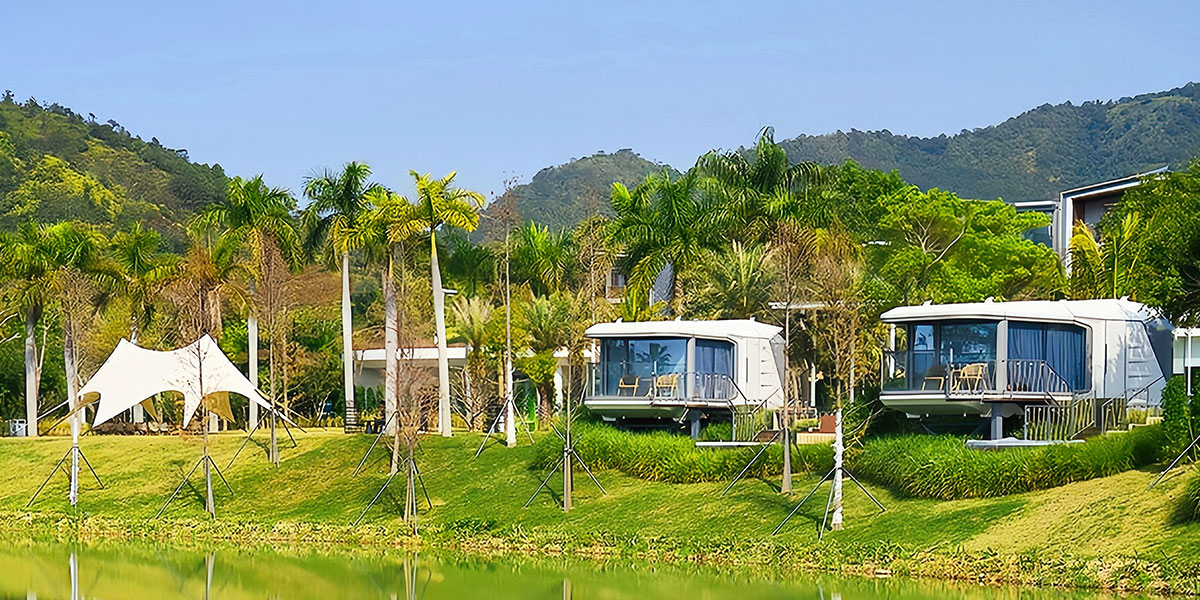 Prefab Capsule House Design
Prefab Capsule House Design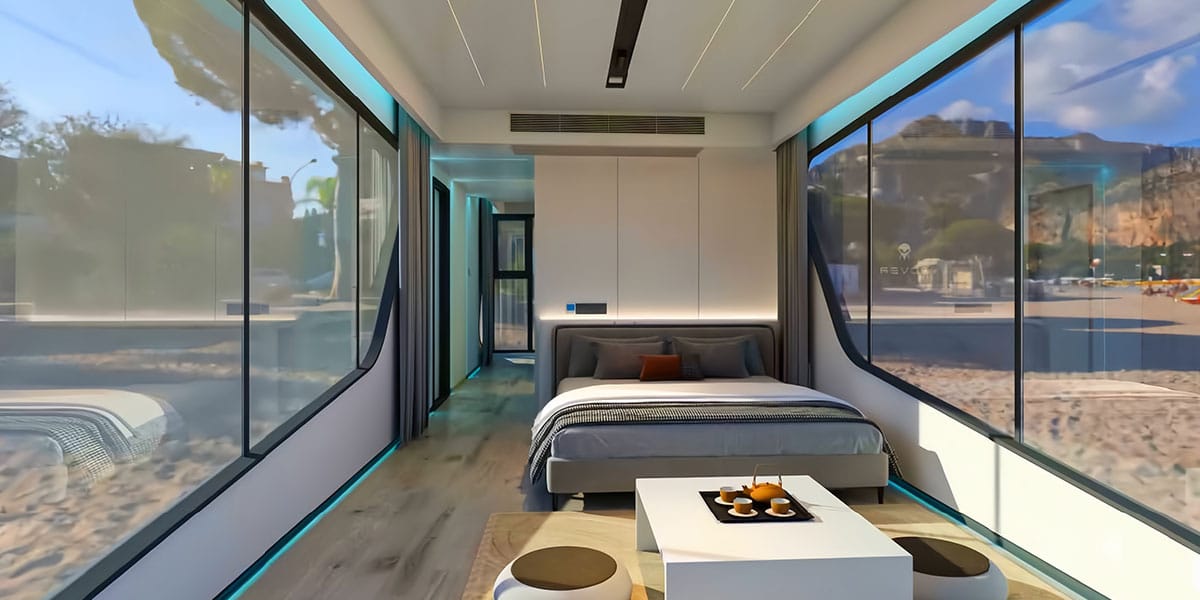 Prefab Capsule House Efficiency
Prefab Capsule House Efficiency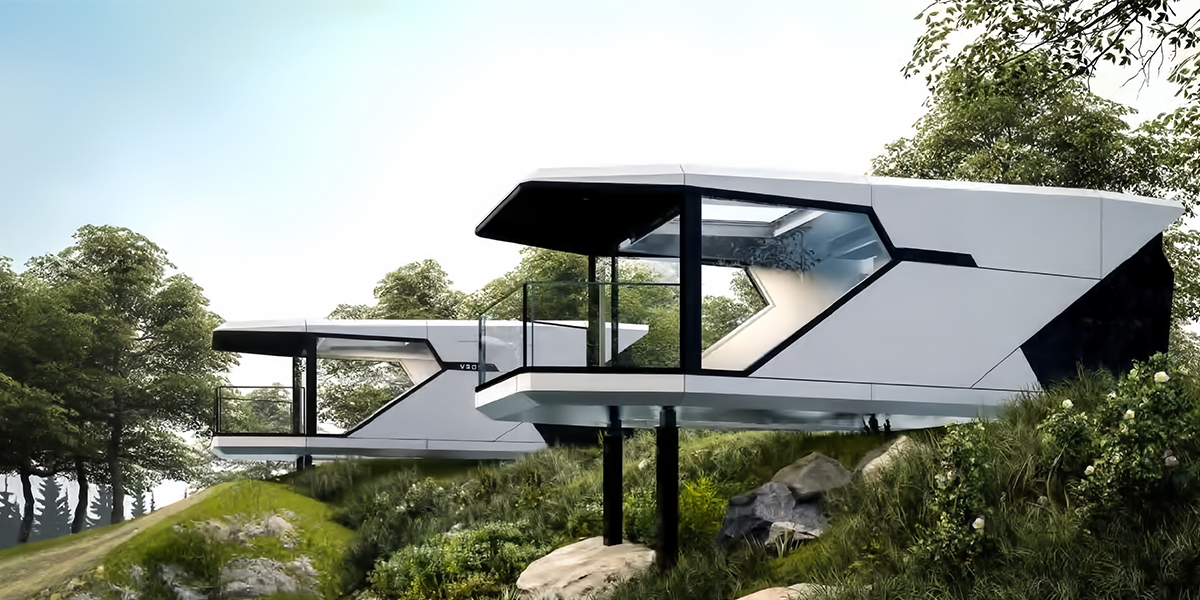 Lifestyle Fit
Lifestyle Fit